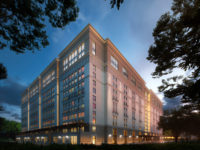New York City felt “baited-and-switched,” says Gregg Pasquarelli, the principal of SHoP Architects, explaining how his firm came to design Barclays Center, the 675,000-square-foot arena in Brooklyn, home to the Brooklyn (formerly New Jersey) Nets. The arena officially opens tonight with a Jay-Z (aka Hova) concert. The bait-and-switch occurred when Bruce Ratner, the developer of the arena, dangled a design by Frank Gehry, helping him win city approval for the project, then dropped Gehry after the financial meltdown of 2008. By spring of 2009, Ratner found himself with no design for the building, and a looming deadline: a tax law change that would have cost him hundreds of millions of dollars if the building wasn’t “in the ground” by the end of the year.
So Ratner turned to design-build firm Hunt Construction; Hunt suggested hiring Ellerbe Becket, architects of venues for nearly half of the thirty National Basketball Association teams. Ratner’s team began touring those arenas, looking for one they could reproduce in Brooklyn, sidestepping months or years of design work. They settled on the Conseco Fieldhouse (now Bankers Life Fieldhouse) in Indianapolis, which was completed in 1999, and began ordering the steel to build a version of it at the intersection of Flatbush and Atlantic Avenues. But the new designed betrayed its Indiana roots. “A colossal, spiritless box,” wrote New York Times critic Nicolai Ouroussoff, adding that the building “would fit more comfortably in a cornfield than at one of the busiest intersections of a vibrant metropolis.”
Swayed by the criticism, Ratner eventually turned to SHoP, which is known not only for its innovative architecture, but also for its high-tech approaches to fabrication and construction. Ratner asked the firm to come up with a new look for arena, retaining the Ellerbe Beckett structure. The SHoP partners envisioned a weathered steel façade that Pasquarelli describes as “snakeskin designed by Richard Serra and Coco Chanel,” which would cover the arena and a large oculus that projected out over the triangular plaza in the front of the building, like a giant, pierced tongue. A new subway entrance, tucked under a canted lawn, would open onto the plaza, from which the scoreboards inside the arena would be visible, creating the link between sidewalk and interior that Gehry had envisioned. Ratner gave SHoP “seven weeks to detail and cost the redesign,” says Pasquarelli. Twenty-five SHoP staffers worked around-the-clock until Labor Day. “I hope we never have a summer like that again,” he says. (Ellerbe Becket, which became part of AECOM in October 2009, remained on the project as architect of record.)
But SHoP’s role went far beyond the design. Using CATIA software (a computer aided three-dimensional interactive application), the firm specified the new façade’s 12,000 unique pieces, then helped build a facility in Indianapolis where those piece were both fabricated and pre-weathered. A custom iPhone app made it possible to track each of the components from the moment it was created to the moment it was installed in Brooklyn. By staying in control of the façade, the firm avoided having it “value engineered,” says Pasquarelli.
And then came the glamor part—working with Nets co-owner Jay-Z on the building’s interior, including The Vault, a halftime hangout for big spenders, where a black epoxy floor, copper mesh panels lit from above, and dark leather banquettes simulate “a premium night club space,” says SHoP principal Christopher Sharples. Most of the borough’s 2.5 million residents will never see The Vault, but they can’t avoid seeing the arena—and their reactions will help determine its success.





